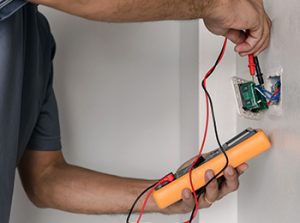Find out more about landlord and tenant responsibilities, home adaptations, safety checks and improvements.
The RMHS wants to keep your home in good condition. This means that the responsibility for repairing and maintaining your home is shared between you and the Society. You are also responsible for looking after your home, including decorating the inside.
All requests for repairs must be reported to the Society as soon as you become aware of them. The Society is obligated to check the asbestos register before any repair is commissioned.
Landlord and tenant responsibilities
The tenancy agreement gives you and the Society rights and obligations about repairing and maintaining your home. In addition, you must keep the inside of your home clean and clutter-free for your safety.
Find out who’s reponsible for repairs to the property.

Repair description and responsibility
- Chimney and stack – RMHS
- Roof structure and covering – RMHS
- Guttering, rainwater pipers – RMHS
- Facias, soffits, barge board – RMHS
- Conservatory repair (existing structures only) – RMHS
- Conservatory cleaning – Tenant
Repair description and responsibility
- External walls and render – RMHS
- Foundations – RMHS
- Concrete canopies – RMHS
- Door canopies – RMHS
- Coping stones – RMHS
- Tenant’s own garden features – Tenant
Repair description and responsibility
- Window frames and sills – RMHS
- Glazing – RMHS
- Glazing, when damaged by tenant/visitor – Tenant
- Window ironmongery – RMHS
- Door frames – RMHS
- External doors – RMHS
- Threshold strips – RMHS
- Door locks and ironmongery – RMHS
- Damaged locks by tenants – Tenant
- Additional keys – Tenant
- Gaining entry (lost keys) – Tenant
- Letter plates – RMHS
Repair description and responsibility
- Stairs – RMHS
- Bannister and handrails – RMHS
- Gloss painting – Tenant
Repair description and responsibility
- Kitchen cupboards and units – RMHS (Tenant to pay if negligent)
- Draws and doors – RMHS
- Handles and plinths – RMHS
- Catches and hinges – RMHS
- Worktops – RMHS
Repair description and responsibility
- Soil and vent pipes – RMHS
- Drains and gully surrounds – RMHS
- Gully grids – RMHS
- Manhole covers – RMHS
- Blocked drains – RMHS (Tenant to pay if negligent)
- Underground bursts – RMHS
Repair description and responsibility
- Garden maintenance – Tenant
- RMHS’ boundary walls or fence – RMHS
- Gates – RMHS
- Paths, steps and other means of access – RMHS
- Rotary lines – Tenant
- Concrete line posts – RMHS
- Garden shed and outbuildings – Tenant
Repair description and responsibility
- Internal sills, uPVC or timber – RMHS
- Skirting boards – RMHS
- Window vents – RMHS
- Door handles and latch – RMHS
- Easing and adjusting – RMHS
Repair description and responsibility
- Internal walls – RMHS
- Major plaster repairs – RMHS
- Minor plaster repairs – RMHS
- Hairline cracks in plaster – Tenant
- Wall tiles – RMHS
- Regrouting – RMHS
Repair description and responsibility
- Concrete floors – RMHS
- Vinyl flooring – Tenant
- Floorboards and joists – RMHS
- Carpets and laminates – Tenant
- Door strips – Tenant
Repair description and responsibility
- Light bulbs – Tenant
- Fluorescent light bulbs – Tenant
- Security lighting – Tenant
- Tenant’s own security light – Tenant
- Light pendants and fittings – RMHS
Repair description and responsibility
- Fire surrounds – RMHS
- Chimney sweeping – RMHS
- Replacement fires due to fault – RMHS
- Tenant’s choice fireplace – Tenant
Repair description and responsibility
- Bathroom suite – RMHS
- Bath panels – RMHS
- Airing cupboard shelves – Tenant
- Internal pipe boxing – Tenant
- Toilet roll holders – Tenant
- Shower curtains – Tenant
Repair description and responsibility
- Draughtproofing to windows and doors – RMHS
- Hot water cylinder jackets – RMHS
- Loft insulation – RMHS (possible grant)
- Cavity wall insulation – RMHS (possible grant)
- Energy efficient light bulbs – Tenant
- Draughtproofing to windows and doors – RMHS
Repair description and responsibility
- Glossing and staining – Tenant
- External redecoration (5-year programme) – RMHS
- Internal redecoration – Tenant
Repair description and responsibility
- Water service pipes, overflows and tanks – RMHS
- Blocked sinks, baths, basins – RMHS (Tenant to pay if negligent)
- Taps, stop taps and wheel valves – RMHS
- Blocked toilets – RMHS (Tenant to pay if negligent)
- Sink units – RMHS
- Toilet flushing mechanism – RMHS
- Toilet seats – Tenant
- Shower trays – RMHS
- Blocked level access shower – RMHS
- Plugs and chains – Tenant
- Showers, if owned by RMHS – RMHS
- Tenant’s own shower – Tenant
- Silicone sealant – RMHS
- Bleeding of radiators – RMHS
- Shower heads and hoses – Tenant
Repair description and responsibility
- Repairs and renewals – RMHS
- Hairline cracks – Tenant
- Patch repairs – RMHS
- Full ceiling decorations – Tenant
[Download not found] (PDF | 135kb)
Adaptations, safety checks and home improvements
Find out what adaptations or improvements you can make and what safety checks are carried out.
 The RMHS’ object is to provide homes for retired ministers. Some ministers also retire on ill-health grounds. Over time, the ability to manage day to day tasks becomes difficult. The Society facilitates and supports your independent living by carrying out alterations to meet these special needs.
The RMHS’ object is to provide homes for retired ministers. Some ministers also retire on ill-health grounds. Over time, the ability to manage day to day tasks becomes difficult. The Society facilitates and supports your independent living by carrying out alterations to meet these special needs.
On adaptations that are likely to cost more than £1,000, we apply the following criteria:
a) it must relate to the tenant or your spouse/partner; and
b) you are registered disabled; or
c) there is a written assessment/report from an occupational therapist. The Society helps the tenant to access this service to ensure there is no delay.
Some examples include, but are not limited to:
- access ramp
- walk-in shower
- widening doorways
- lowering switches
- ground floor toilet
- low access baths
- over-shower baths
- changes to internal layout
- stair lifts
- extensions
Where adapting your home may not be the best option, we will discuss alternative longer-term solutions with you.
 By law, every 12 months, the RMHS must carry out gas safety test to make sure your central heating system and appliances are safe. It is therefore obligatory to give access to the Society or its agents to your premises, providing we give you adequate notice, unless it is an emergency.
By law, every 12 months, the RMHS must carry out gas safety test to make sure your central heating system and appliances are safe. It is therefore obligatory to give access to the Society or its agents to your premises, providing we give you adequate notice, unless it is an emergency.
If you suspect a gas leak or smell gas:
- put out all visible flames
- turn off the gas supply at the meter
- do not touch or operate any electrical switch
- do not smoke or strike matches
- open all doors and windows
- call the Gas Emergency Helpline number 0800 111 999
- leave the property until help arrives
 All the RMHS’ properties are fitted with smoke alarms and carbon monoxide detectors for your safety. Surveyors visits show that some of you relocate the smoke alarms because they go off and cause annoyance.
All the RMHS’ properties are fitted with smoke alarms and carbon monoxide detectors for your safety. Surveyors visits show that some of you relocate the smoke alarms because they go off and cause annoyance.
These are provided for your protection and should not be removed, relocated or painted.
Whenever possible, test the smoke detector regularly (or request a visitor to assist, if you are unable to reach it) by pressing the button on the panel. A high frequency, shrill sound will indicate that it is in a good working order.
The Society is increasingly wiring the smoke alarms to the electric supply to avoid total reliance on batteries. If the smoke alarm in your home is battery operated and starts bleeping, it requires a battery change, and you are responsible for this.
Contact the office if your hardwired smoke alarm or carbon monoxide detector starts bleeping.
 By law, the RMHS is required to carry out electrical safety checks in your home every five years. This ensures that all the appliances and connections in your home are in good working order and where faults or potential problems are detected, they are resolved as soon as possible.
By law, the RMHS is required to carry out electrical safety checks in your home every five years. This ensures that all the appliances and connections in your home are in good working order and where faults or potential problems are detected, they are resolved as soon as possible.
All our electrical installations and safety checks are carried out by qualified and registered National Inspection Council for Electrical Installation Contracting (NICEIC) service providers.
We advise that you do not engage in DIY electrical works in your home because not only it is dangerous, but also will compromise the safety certificate we hold.
The Society has set up buildings insurance for your home, which includes fixtures and fittings, such as windows, doors, boilers and fixed sanitary ware. The insurance does not cover your personal belongings, wall and ceiling decorations.
If you do not have personal contents cover, we strongly advise that you do so to cover losses in case of theft, loss, fire and flood.
All damage due to vandalism, theft or attempted theft must be reported to the police. Damage to the property because of anything you, your family or visitors did or because of neglect will become your responsibility to make good.
We advise that you report any damage to the Society immediately.
 You have the right to improve your home and in order to do so, you must write to the Society for consent.
You have the right to improve your home and in order to do so, you must write to the Society for consent.
The Society will not refuse a reasonable request, however, depending on the type of work you are planning to undertake, you may require other approval, such as planning permission or building warrant. If agreed, the work must be to a standard set out in the consent letter.
The Society reserves the right to refuse such requests if planning permission has been refused, the alteration would be detrimental to the fabric of the property or could compromise selling the property in the future.
Please also see below about conservatories, which will not be permitted.
Where a tenant feels that the approved improvement/alteration to the property would increase the value of the property, they must get the property surveyed before and after the works. To eliminate disproportionate administration costs, qualifying works must cost more than £10,000.
Conservatories were once very popular, and many householders wanted them. Even the Society was once seduced by them and used to refund, in shares, the cost of installing one. Because most conservatories were exempt from building regulations, the quality and standard varied. Many companies that installed conservatories in the last 20 years are no longer in business and therefore warranties and guarantees have become difficult to claim against.
Typical faults with many conservatories include:
- foundation problems
- roof abutments and roof flashings
- valley gutters and details
- roofs
- poor workmanship
- maintenance to existing buildings
Because of repair costs associated with these, the Society no longer purchases properties that have conservatories and will not replace any existing ones when they become uneconomical for further repairs.


